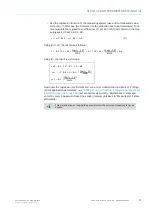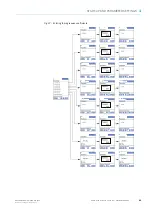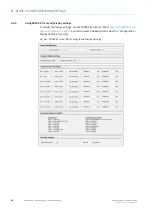
79
8011952/YWL2/3-0/2016-08| SICK
O P E R A T I N G I N S T R U C T I O N S | DUSTHUNTER C200
Subject to change without notice
START-UP AND PARAMETER SETTINGS
4
Enter the regression coefficients
There are two options:
– Direct input of K2, K1, K0 in a measured value computer.
– Use the regression function of the measuring system (use without measured value
computer).
In this case, the correlation to the scattered light intensity has to be determined. To do
this, calculate the regression coefficients cc2, cc1, cc0 to be entered in the
measuring system from K2, K1, K0.
Using (2) in (1), the result is as follows:
Using (3), the result is as follows:
Now enter the regression coefficients cc2, cc1 and cc0 determined in directory “Configu-
ration/Application parameters“ (
see “SOPAS ET menu: DH C200/Configuration/Application
) (set sender/receiver unit to “Maintenance” state and
enter the Level 1 password. Reset the sender/receiver unit back to “Measurement” state
afterwards).
NOTE:
In this case, the regression coefficients set in the sender/receiver unit and the
measuring range set in the MCU may not be changed anymore. On the optional
LC Display (when used), the dust concentration is displayed as uncalibrated
value in mg/m³.
c
cc2 SL
2
⋅
cc1 SL
⋅
cc0
+
+
=
(3)
c
K2
LZ SL
20mA LZ
–
MBE
-----------------------------
⋅
+
2
K1
LZ SL
20mA LZ
–
MBE
-----------------------------
⋅
+
K0
+
⋅
+
⋅
=
cc1
2 K2 LZ K1
+
⋅
⋅
(
)
20mA LZ
–
MBE
-----------------------------
⋅
=
cc0
K2 LZ
2
⋅
K1 LZ
⋅
K0
+
+
=
cc2
K2
20mA LZ
–
MBE
-----------------------------
⋅
2
=
This method allows changing the parameters for the selected measuring range as
desired.
















































